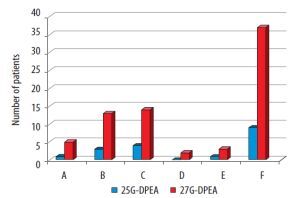ANAESTHESIOLOGY - REGIONAL ANAESTHESIA / ORIGINAL ARTICLE
A randomized comparative study of 25-gauge vs. 27-gauge pencil-point spinal needles during dural puncture epidural anesthesia for elective cesarean section
1
Department of Anesthesia, Surgical ICU and Pain Management, Faculty of Medicine, Cairo University, Cairo, Egypt
2
Department of Anesthesiology, Intensive Care and Pain Management, Faculty of Medicine, Al-Azhar University, Damietta, Egypt
3
Department of Anesthesia and Intensive Care, Faculty of Medicine, Aswan University, Aswan, Egypt
4
Department of Anesthesiology, Surgical ICU and Pain Management, Faculty of Medicine, Beni-Suef University, Beni-Suef, Egypt
Submission date: 2024-07-04
Final revision date: 2024-11-28
Acceptance date: 2025-01-16
Anaesthesiol Intensive Ther 2025;(1):18-28
KEYWORDS
elective caesarean sectionparturientdural puncture epiduralonset time to surgical anesthesiaWhitacre needles
TOPICS
ABSTRACT
Background:
Dural puncture epidural anesthesia (DPEA) has become effective during normal labor. There were insufficient data about DPEA during cesarean section (CS).
Methods:
A total of 110 ASA I and II parturients aged 20–35 years old underwent scheduled CS using DPEA with either 25G or 27G Whitacre needles. A T10 sensory block was achieved and maintained using a low concentration of bupivacaine with fentanyl through the epidural catheter until the end of surgery. Epidural extension anesthesia was initiated inside the operating room. The primary outcome was time taken from the start of epidural extension until achievement of bilateral T6 sensory block. The secondary outcome was quality of DPEA (composite).
Results:
The primary outcome, median (IQR) time to surgical anesthesia, was 9.12 (8.71–18.54) minutes in the 25G-DPEA group and 14.18 (12.43–23.56) minutes in the 27G-DPEA group. The difference in the onset time of sensory block between the 2 groups was 5.06 (3.72–5.02) min, which was statistically significant (HR: 2.3; 95% CI: 1.79–3.14%; P < 0.0001). Failure of DPEA was observed in 9 of 55 parturients (16.4%) in the 25-DPEA group compared with 37 of 55 parturients (67.3%) in the 27-DPEA group (OR = 0.095; 95% CI: 0.04–0.24 %; P < 0.0001). Adverse effects and neonatal outcomes were comparable between the two groups.
Conclusions:
25G-DPEA resulted in faster onset and improved block quality during epidural extension compared with 27G-DPEA. Further studies are needed to confirm these findings in the setting of intra-partum CS.
Dural puncture epidural anesthesia (DPEA) has become effective during normal labor. There were insufficient data about DPEA during cesarean section (CS).
Methods:
A total of 110 ASA I and II parturients aged 20–35 years old underwent scheduled CS using DPEA with either 25G or 27G Whitacre needles. A T10 sensory block was achieved and maintained using a low concentration of bupivacaine with fentanyl through the epidural catheter until the end of surgery. Epidural extension anesthesia was initiated inside the operating room. The primary outcome was time taken from the start of epidural extension until achievement of bilateral T6 sensory block. The secondary outcome was quality of DPEA (composite).
Results:
The primary outcome, median (IQR) time to surgical anesthesia, was 9.12 (8.71–18.54) minutes in the 25G-DPEA group and 14.18 (12.43–23.56) minutes in the 27G-DPEA group. The difference in the onset time of sensory block between the 2 groups was 5.06 (3.72–5.02) min, which was statistically significant (HR: 2.3; 95% CI: 1.79–3.14%; P < 0.0001). Failure of DPEA was observed in 9 of 55 parturients (16.4%) in the 25-DPEA group compared with 37 of 55 parturients (67.3%) in the 27-DPEA group (OR = 0.095; 95% CI: 0.04–0.24 %; P < 0.0001). Adverse effects and neonatal outcomes were comparable between the two groups.
Conclusions:
25G-DPEA resulted in faster onset and improved block quality during epidural extension compared with 27G-DPEA. Further studies are needed to confirm these findings in the setting of intra-partum CS.
We process personal data collected when visiting the website. The function of obtaining information about users and their behavior is carried out by voluntarily entered information in forms and saving cookies in end devices. Data, including cookies, are used to provide services, improve the user experience and to analyze the traffic in accordance with the Privacy policy. Data are also collected and processed by Google Analytics tool (more).
You can change cookies settings in your browser. Restricted use of cookies in the browser configuration may affect some functionalities of the website.
You can change cookies settings in your browser. Restricted use of cookies in the browser configuration may affect some functionalities of the website.



